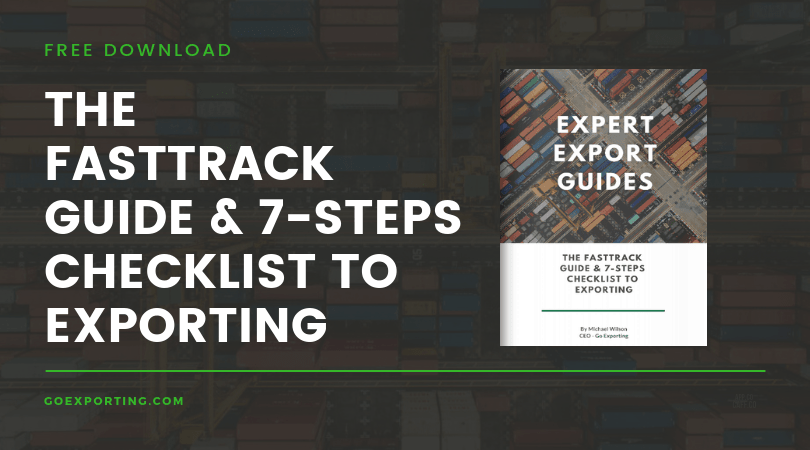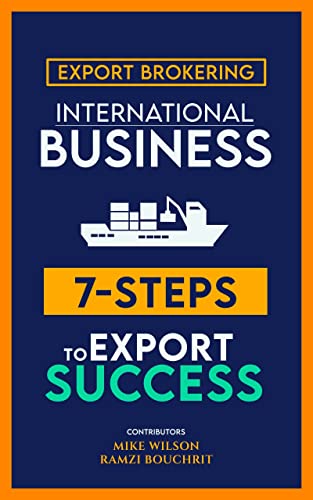CEO of Go Exporting, Mike Wilson, has contributed 10 top tips to a global publication of 1001 business tips from 101 exporters and global trade advisors.
The publication, arranged by The Belmont Business Enterprise Centre Inc in Australia, will form part of an e-book to support sole traders and SMEs in expanding their exporting skills and knowledge, and how best to prepare for a national export development grant program.
The 10 contributions from Mike Wilson were:
- Define your objectives
- Prepare your export readiness action plan
- Discovering where to export
- Finding focus
- Choosing routes to market
- Assessing pricing and market entry viability
- Creating a bespoke international marketing plan
- Defining how to implement that plan
- Compiling a detailed export plan
- Reviewing and refining your approach
Interested in expanding your business into new Scandinavian markets? Then you’re in luck!
Earlier this month, Go Exporting CEO Mike Wilson joined Business Wales for a webinar advising delegates as to the export opportunities in Denmark and Sweden.
The webinar included details on market statistics, administrative structure, key sectors and opportunities, business culture and post-Brexit dynamics.
Watch the webinar in full below.
Looking to expand internationally but aren’t sure where to start, or lack the internal resources to drive international growth? Go Exporting specialises in helping firms like yours to open a world of opportunities.
Learn more about our international trade consultancy services here.
The next government needs to deliver a better trading relationship with the EU as a matter of priority.
That’s the view of the British Chambers of Commerce, one of the most influential business networks, set out as part of its Future of the Economy Manifesto for 2024.
The manifesto focuses on five key areas of the UK economy, from green innovation and digital, to people, work, and global Britain.
The manifesto notes that: “There is a clear need to improve trading relationships with the EU, which remains our biggest trading partner.
“Retaining Britain’s place on the global stage also means keeping our most successful businesses who may be looking overseas for finance. British growth capital should be made more accessible.
“Finally, the government should only diverge from EU rules where it adds value to UK plc. We encourage close alignment on regulations that impact Britain’s global trade, such as standards on manufactured goods, while supporting divergence where there is a clear benefit, such as the Mansion House reforms that will help unlock additional investment for UK firms.”
The manifesto put forward three key recommendations for growing global trade;
- Implement trade deals which improve export potential for business
- Grow foreign direct investment into the UK
- Continue reforms to increase UK investment
A Swiss solution?
William Bain, BCC Head of Trade Policy, said that the UK should be looking towards a Swiss-style deal with the EU after a recent trip to the country.
He said that: “Switzerland is one of the UK’s strongest trading partners with a depth to its finance and services trade that mirrors our own. It is also at the heart of Europe’s life sciences and pharmaceutical industries.
“As a member of the European Free Trade Area, while sitting outside the European Economic Area, it can set its own course on many regulatory issues.
“But it retains close links with the EU Single Market, particularly in goods. These have been developed through bilateral agreements with Brussels over the past half a century, though Switzerland is also a full participant in the Schengen Zone, allowing friction-free movement through Swiss territory for qualifying citizens.”
Grow through the growing pains with Go Exporting
If Brexit has hampered international trade growth, or put the brakes on your export plans altogether, then we can help.
Go Exporting are the industry experts in helping firms to open a world of opportunities abroad, from identifying potentially profitable markets, to putting in place the export strategy and distributors to get you there.
Interested? Learn more about our international trade consultancy here.
UK exporters are being urged to transition to the Customs Declaration Service (CDS) before the 4th of June deadline to ensure the continued smooth processing of their export declarations. With less than a month remaining, HMRC has intensified calls for businesses to make the switch from the current Customs Handling of Import and Export Freight (CHIEF) system to the new CDS.
Why the change?
The transition to the CDS is part of the government’s ongoing efforts to modernise and streamline customs processes. The new system promises enhanced capabilities, including improved data integration and greater flexibility in managing customs procedures. The CHIEF system, which has been in operation for decades, will be completely phased out, marking a significant shift in how export declarations are handled.
Sarah Hartley, HMRC’s Director of Border Change Delivery, said: ”There are just weeks left for businesses to migrate their export declarations to CDS – those who have yet to move need to do so now.
“Anyone who needs help migrating to CDS should work with a customs agent who is ready to use the system and can make declarations on their behalf.”
Support and resources available
To assist businesses in this transition, HMRC has provided a variety of resources, including a CDS toolkit and checklists. Exporters are encouraged to utilise these tools to ensure they are fully prepared for the switch.
Businesses that fail to adopt the CDS by the deadline may face significant disruptions to their export operations.
Steps to transition
Exporters should start by familiarising themselves with the CDS and its requirements. Key steps include:
- Registering for the CDS: Businesses need to sign up for the service through the Government Gateway.
- Understanding the new data requirements: The CDS requires more detailed information than CHIEF, so exporters should review the new data fields and ensure they have the necessary information ready.
- Updating software: If businesses use customs declaration software, they must ensure it is compatible with the CDS. HMRC provides a list of approved software providers.
- Training staff: Employees who handle customs declarations will need to be trained on the new system to ensure a smooth transition.
Exporters keen to understand the main differences between the two systems can do so with this gov article.
Do you want to learn the secrets of selling internationally from export experts with over 30 years of experience helping businesses expand globally?
Then this webinar is for you.
On Wednesday 31st January at 12pm, SIITACE (The Society of Independent International Trade Advisors & Customs Experts) is presenting an exciting online event where they’ll share valuable insights on selling internationally.
Discover the secrets to expanding your customer base beyond borders and tapping into new markets.
The expert speaker will guide you through the process, covering topics such as:
– Are you ready to sell internationally?
– How to choose the right markets
– The importance of focus
– Who is the customer?
– Decision-making drivers
– Sales Approach
– Developing your Value Proposition
– Route to Market Options
Don’t miss this opportunity to learn from industry leaders and gain the knowledge you need to succeed in the global marketplace. Sign up now!
https://www.eventbrite.co.uk/e/how-to-sell-internationally-tickets-795385588707
“The facts are clear. Businesses which trade internationally are more resilient, more sustainable, employ more people and are more profitable.”
Those are the words of Marco Forgione, director general of the Institute of Export and International Trade. And a new report suggests we can add another adjective to that list – more productive.
A feasibility study published by the London School of Economics on behalf of the government has found that businesses which export are increasingly productive compared to non-exporting firms. And there are a number of reasons for this.
The report suggests that UK businesses can learn a lot from international partners, clients and customers – especially when exporting to advanced economies.
Exporting firms that are also prolific importers are also more able to weather economic storms that can affect supply chains by having a more diversified route to materials. Importing businesses also have increased scope to source different materials and technologies.
In fact, the productivity improvements from training internationally range from three to 22%.
You can read the stody in full on the government website here.
Capitalise on the opportunities of exporting
Is your business making the most of global opportunities?
Exporting for the first time or growing an existing operation into new markets can seem a daunting task, and a lack of internal knowledge and resources is a key reason why many firms avoid expanding further afield.
At Go Exporting, we help businesses to accurately identify profitable target markets and create a roadmap to achieving success in that territory, with as much or as little support as needed to make those exporting goals become a reality.
Learn more about our international trade consultancy services here.
Research commissioned by the British Beauty Council has found that Brexit has severely impacted the UK beauty sector, with SMEs especially affected.
The research, conducted by Oxford Economics, found that customs delays, increased costs associated with cross-border trade and a reduction in skilled EU workers entering the UK economy have shrunk the value of the UK beauty industry’s exports into the continent by £850m.
The research looked at sales trends before and after the UK’s departure from the European Union and found that, whilst sales increased in 2010 and 2016, exports have been in decline ever since the Brexit vote.
Interestingly, export values from UK beauty firms into the global marketplace have remained steady – its EU sales which have declined.
Head of trade policy at the BCC, William Bain, noted that: “The reality is if UK business is to thrive, then we must export more, it’s as simple as that. If we want to remain one of the world’s largest economies, then we need more firms selling goods and services internationally.
“The pandemic, supply chain disruption, Brexit, non-tariff trade barriers and global headwinds have all made this more difficult over the past few years.”
Read more: Growing crisis for UK’s exporting industry
This report, although damaging for the impact Brexit has had on trade with the EU, highlights the advantages of setting corporate sights further afield.
By targeting a global audience rather than just within the Eurozone, UK firms have an opportunity to find new customers – potentially in territories where competition is lower, or there is huge demand for their products and services.
To find out how export-ready your business is, take a quick and free quiz right here and get an instant assessment report on areas you need to work on to start taking advantage of the global opportunities that are out there.
Is your business ready to expand globally and capitalise on a world of opportunities that awaits?
You can assess your readiness for export with our free Export Readiness Quiz! Answer just 16 questions and we’ll provide you with an Export Readiness Score and breakdown of the areas where you need to pay attention to be in a position to successfully start or expand your journey into international markets.
We look at four key areas:
Company – How prepared is your business, it’s people, systems and procedures for export?
Market Knowledge – How well do you know your potential market and where the best opportunities lie?
Export Strategy – Is your strategy sufficiently defined and detailed to ensure export success?
Barriers to Entry – How aware are you of the barriers to entry such as customs rules and regulations, competition, product development requirements?
The final report will identify recommended improvements and further actions you should take to be a successful exporter. From this you can develop your Export Readiness Action Plan.
There is a world full of opportunities out there. Carefully planning and preparing will help you to profitably expand into international markets.
Don’t delay. Start today! Take the quiz here.
A straw poll as part of UK exporters has unearthed how unprepared most are for upcoming changes to the British border and how they will affect them.
Taken on an Institute of Export & International Trade webinar, just 6% of attendees said they were ‘completely clear’ about upcoming changes, whilst 16% said they were ‘clear’.
The question relates to the government’s Border Target Operating Model which sets out how the UK will approach checks on some goods entering from the EU – including several sanitary and phytosanitary (SPS) requirements.
The new border controls are designed to protect the UK against security and biosecurity threats and to ensure a smooth flow of goods, delivered as part of the 2025 Border Strategy.
Kevin Shakespeare of the IOE&IT noted: “There’s a lot going on in the trade and customs space in the UK. It can be a challenge to keep up, but there are also opportunities for businesses operating compliantly, that take the time to analyse and stay up-to-date on the changes.”
The 200-page document explains how the UK will adopt a digitised and risk-based approach to border checks with agencies conducting different levels of checks depending on the risk category of the product.
The same approach will then also be applied to non-EU goods entering GB.
IOE&IT customs specialist Anna Doherty further explained: “The impact of the model will vary depending on what you trade.
“For example, for exporters of SPS goods, the EU has been implementing controls right from the end of the transition period. To bring these checks into the UK will even out the playing field for these businesses.
“The model is also bringing in a range of simplifications. If you’re bringing in SPS goods from the rest of the world, then the modernisation in this regime will allow you to align your processes.”
Read more: Planned post-Brexit checks on EU food imports delayed again
UK importers and exporters have more to contend with too over the next 18 months, including the migration to CDS for exporters, a new NCTS5 system for transit, and the Windsor Framework.
Three key milestones that exporters need to know as part of the British Border Operating Model include:
- 31 January 2024 – The introduction of health certification on imports of medium-risk animal products, plants, plant products and high-risk food (and feed) of non-animal origin from the EU
- 30 April 2024 – The introduction of documentary and risk-based identity and physical checks on medium-risk animal products, plants, plant products and high-risk food (and feed) of non-animal origin from the EU. At this point, Imports of Sanitary and Phytosanitary goods from the rest of the world will begin to benefit from the new risk-based model
31 October 2024 – Safety and Security declarations for EU imports will come into force from 31 October 2024. Alongside this, we will introduce a reduced dataset for imports
If your business is yet to fully understand what upcoming changes mean for continued operations, Go Exporting can help you uncover the practical steps you need to make to remain compliant, continue seamless trade, and even spot an opportunity for growth.
Find out more about our customs and compliance reports, or get in touch directly here.
The Department for Business and Trade has announced a new trade agreement with Washington state.
The deal, or memorandum of understanding on trade, is the sixth such agreement that’s been made which in total offers UK businesses further opportunities to tap into markets worth £2.2tn.
BREAKING: tonight the UK will sign a memorandum of understanding on trade with Washington state 🇬🇧🇺🇸
— Department for Business and Trade (@biztradegovuk) September 25, 2023
This means we'll have signed MoUs with six US states, which had a combined GDP of £2.2tn in 2022 – offering new opportunities for UK businesses ✅
More: https://t.co/GRmmhupb3V pic.twitter.com/t8YsOZijXt
The memorandum with Washington focuses on aerospace with the State the home of Boeing. Industries minister, Nusrat Ghani, will travel to Seattle shortly to sign the pact and lead 35 UK firms at a joining Boeing and Department for Business and Trade showcase event.
The UK has already signed MoUs with Indiana, North Carolina, South Carolina, Oklahoma and Utah.
Ghani said of the agreement: “Our pact with the state of Washington is a win for the UK, opening a door for our businesses to trade more openly and unlock new opportunities in key sectors.
“Each US state is a massive global market in its own right, and many have economies larger than the GDP of whole countries. By notching up our sixth such deal we’ve surpassed the £2 trillion mark for combined GDP of states who’ve done a deal with the UK, with many more in our sights.”
Read more: Marr: Growing crisis for UK’s exporting industry
“This particular deal will be fantastic for our aerospace industry through investor intros, trade missions, and increasing access to procurement markets. I’m delighted to join Boeing and our handpicked group of innovative UK companies to discuss how Government and industry can work together to create jobs and grow the economy.”
The UK is striking deals with individual States in lieu of a comprehensive trade agreement with the United States – a prize that has long been sought since Brexit. However, US concerns over the Irish border since leaving the EU has put talks on hold.









